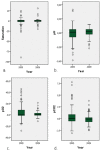Quality of interhospital transport of the critically ill: impact of a Mobile Intensive Care Unit with a specialized retrieval team
- PMID: 21356054
- PMCID: PMC3222008
- DOI: 10.1186/cc10064
Quality of interhospital transport of the critically ill: impact of a Mobile Intensive Care Unit with a specialized retrieval team
Abstract
Introduction: In order to minimize the additional risk of interhospital transport of critically ill patients, we started a mobile intensive care unit (MICU) with a specialized retrieval team, reaching out from our university hospital-based intensive care unit to our adherence region in March 2009. To evaluate the effects of this implementation, we performed a prospective audit comparing adverse events and patient stability during MICU transfers with our previous data on transfers performed by standard ambulance.
Methods: All transfers performed by MICU from March 2009 until December 2009 were included. Data on 14 vital variables were collected at the moment of departure, arrival and 24 hours after admission. Variables before and after transfer were compared using the paired-sample T-test. Major deterioration was expressed as a variable beyond a predefined critical threshold and was analyzed using the McNemar test and the Wilcoxon Signed Ranks test. Results were compared to the data of our previous prospective study on interhospital transfer performed by ambulance.
Results: A total of 74 interhospital transfers of ICU patients over a 10-month period were evaluated. An increase of total number of variables beyond critical threshold at arrival, indicating a worsening of condition, was found in 38 percent of patients. Thirty-two percent exhibited a decrease of one or more variables beyond critical threshold and 30% showed no difference. There was no correlation between patient status at arrival and the duration of transfer or severity of disease. ICU mortality was 28%. Systolic blood pressure, glucose and haemoglobin were significantly different at arrival compared to departure, although significant values for major deterioration were never reached. Compared to standard ambulance transfers of ICU patients, there were less adverse events: 12.5% vs. 34%, which in the current study were merely caused by technical (and not medical) problems. Although mean Acute Physiology and Chronic Health Evaluation II (APACHE II) score was significantly higher, patients transferred by MICU showed less deterioration in pulmonary parameters during transfer than patients transferred by standard ambulance.
Conclusions: Transfer by MICU imposes less risk to critically ill patients compared to transfer performed by standard ambulance and has, therefore, resulted in an improved quality of interhospital transport of ICU patients in the north-eastern part of the Netherlands.
Figures


References
-
- Ministry of Public Health. Temporary guideline coordinating MICU-centers and MICU-transfer. 23-10-2007. http://www.rijksoverheid.nl/documenten-en-publicaties/kamerstukken/2007/...
-
- Beckmann U, Gillies DM, Berenholtz SM, Wu AW, Pronovost P. Incidents relating to the intra-hospital transfer of critically ill patients. An analysis of the reports submitted to the Australian Incident Monitoring Study in Intensive Care. Intensive Care Med. 2004;30:1579–1585. doi: 10.1007/s00134-004-2177-9. - DOI - PubMed
Publication types
MeSH terms
LinkOut - more resources
Full Text Sources
Medical

